The dark and creepy Necromancer is a pillar of the DnD cast, and it is no wonder why. Being able to raise an army of the Undead to carry out your bidding is very tempting and an idea that I have had a ton of fun playing around with.
So, if you’re thinking of making a Wizard character and are considering going the Necromancer route, here is a Necromancer 5e guide to everything you could need to know about picking up the subclass.
Key Info Up Front
- Books: Player’s Handbook
- Feature Levels: 2, 6, 10, 14
- Role: Striker, Summoner
Necromancer Overview
Picking the School of Necromancy for your Wizard character signifies their interest in the power that runs through all living things. As your character continues to study the art of Necromancy, they learn not only how to manipulate the remnants of that energy in the dead to create Undead but also allows them to tear that energy from the targets of their magic so they can use it to empower themselves.
This subclass comes with entertaining combat options, powerful spells, unique features, and many roleplaying opportunities. However, it is essential to note that if you pick this subclass, you must be mindful of the negative opinion toward Necromancy that most cultures in DnD have.
This will impact your roleplay, affect your character’s personality, and likely affect when you choose to use your class features, as walking around with a skeleton following you in a city will likely make people panic.
Ability Scores
When it comes to the ability scores for your Necromancer, you’ll want to follow the usual spread for most Wizards. This means prioritizing your Intelligence above all else, as it is the ability that impacts your spellcasting. After that, I recommend increasing your Constitution.
You likely won’t have to take too many direct hits, but having higher hit points and strong Constitution saving throws a great fallback just in case something happens.
After your Constitution, you should invest in your Wisdom, which will keep your Perception up and help you pass Wisdom saving throws. After Wisdom, focus on Dexterity to get at least a +1 modifier for your Armor Class.
Then you can spread out your remaining scores between either Charisma or Strength. Which one you focus on does not matter much, as they both should be dump stats. You don’t need to hit anything, and you’re a creepy Necromancer, so you shouldn’t be the party’s Face.
Backgrounds
As always, I recommend choosing a background that works best with your character’s backstory before considering which one will give you the most mechanical benefits. I recommend this because it helps make your character exciting and fun to roleplay.
The mechanical benefits you get from a background typically only matter when a character is built min-maxing. However, there are many options in 5e, and if you need help narrowing down the list or want to build a backstory off your background.
Here is a list of the best options for a Necromancer.
- Acolyte (Player’s Handbook): This background comes with two free languages and two skill proficiencies taken a right from the Wizard list. The languages aren’t that useful since you can access them through magic, but the skill proficiencies can be useful. I also like this background for the roleplay opportunities it presents, as explaining how your character went from working in religion to manipulating the forces of life and death is fascinating.
- Cloistered Scholar (Sword Coast Adventurer’s Guide): This background is effectively the better version of the Acolyte. It has the same fun roleplay opportunities while coming with the languages and great skill proficiencies.
- Hermit (Player’s Handbook): The Hermit background also comes with some fun roleplay opportunities, as a secluded wizard manipulating the dead is a great story point to start from. It also comes with two skill proficiencies from the Wizard list, a free language, and will let you use Herbalism Kits to create potions.
- Sage (Player’s Handbook): The Sage is similar to the Hermit background as far as the roleplay opportunities are concerned. It comes with proficiency in two best Wizard skills and two free languages.
Skills
When you first make your Wizard character, you’ll be able to pick from a list of six skills to take proficiency in. Which of these you decide to take will partially depend on your background, as there may be some overlap.
So, here is the order that I recommend taking the skill proficiencies to get as much out of them as you possibly can:
- Arcana: A strong Intelligence skill that is pivotal to the flavor of playing a Wizard and can be extremely useful for identifying spells and magic items you encounter during your campaign.
- Religion: Another strong Intelligence skill that will help you gather information about the world and events of your campaign. With your already high Intelligence, there is a good chance you will be better at it than religion-based classes like the Paladin or Cleric.
- History: History can be a useful knowledge skill to gather information during quests, but your Dungeon Master will have to have the history of the world fleshed out for you to get much out of using it.
- Investigation: Investigation can be useful, but you are better off leaving this skill coverage to other characters in your party if you have any of the above options available.
- Insight: Insight is a mighty skill, but since Charisma is your dump stat, you should just leave this one to your party’s Face.
- Medicine: Medicine is the de facto most useless skill in 5e. Regardless of your class or build, healing is best done with magic, so ignore this skill.
Necromancer Features
Necromancy Savant
Level: 2
When you begin studying in the School of Necromancy, the amount of gold you have to spend and the time you invest to copy Necromancy spells into your spellbook is halved.
Grim Harvest
Level: 2
The Grim Harvest feature is slightly muddy. It makes it so that when you kill a creature with a spell of level one or higher, you regain several hit points equal to twice the spell’s level. If the spell is a Necromancy spell, the number of hit points is boosted to three times the spell’s level. This feature is decently useful, but it can be exploited heavily.
The easiest way is to get your hands on a bag of rats. Then, whenever you need to heal, you can pull out a rat and kill it with a Necromancy spell for some pretty serious healing at a low cost. However, your Dungeon Master may stop this once you start it, so maybe wait until you need the healing to bust it out for the first time.
Undead Thralls
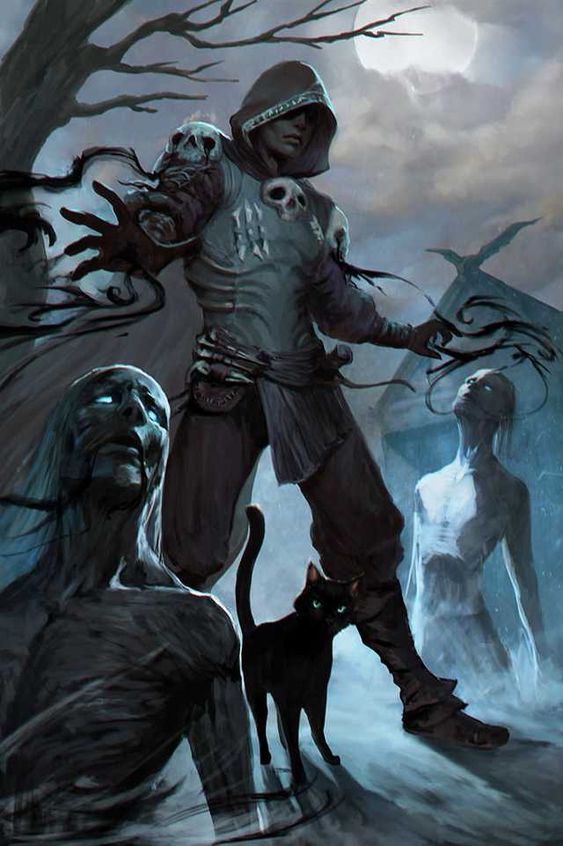
Level: 6
The Undead Thralls feature gives your Necromancer the Animate Dead spell if they don’t already have it to ensure they can start keeping an undead pet or two with them at all times. However, keeping an undead with you consumes spell slots each day, so I recommend just getting one or two first to avoid running out of options in combat.
This feature also buffs your summoned Undead to increase their hit points by your Wizard level and adds your proficiency bonus to their damage rolls. I recommend talking to your Dungeon Master about possibly buffing your Undead with some armor and weapons so they are viable options in combat for longer.
Inured to Undeath
Level: 10
This feature is the most lackluster of the subclass. It prevents your hit point maximum from being lowered by any effect and gives you resistance to necrotic damage. While both of these effects are nice to help keep you on your feet, they are very situational and may not come up often, depending on your campaign.
Command Undead
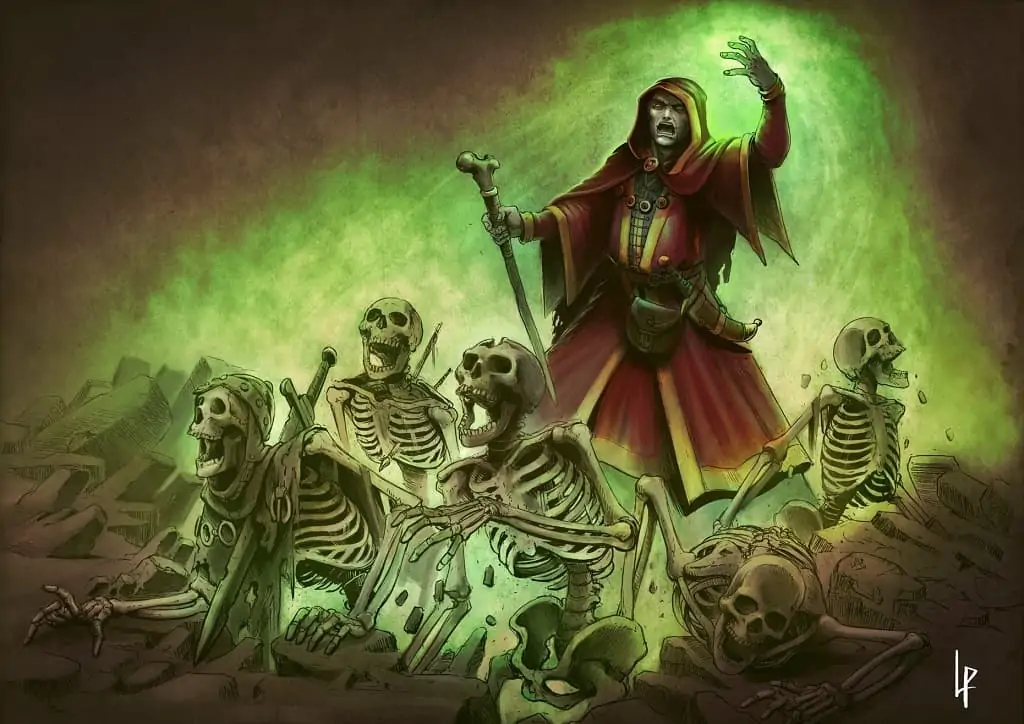
Level: 14
Command Undead allows your character to seize control of Undead created by other Wizards or through any means. To do so, your target has to make a Charisma saving throw. However, if the Undead creature has an Intelligence score of eight or higher, they get advantage on the roll, and if it is 12 or higher, they can repeat the check at the end of every hour. This can make it difficult to take advantage of this feature too frequently at this level, but it can still be useful and fun.
Necromancer Races
While making your character, just about any race can work well enough as a Necromancer. However, there are dozens of options, some better than others. So, here are the very best race picks for your Necromancer.
Aarakocra
Book: Mordenkainen Presents: Monsters of the Multiverse
This version of the Arakocra’s main benefit for the Necromancer is its flight ability. This can help keep you out of the way during fights while your undead thralls carry out the up-close combat on your behalf.
Draconblood
Book: Explorer’s Guide to Wildemount
This race has a little bit of everything. It comes with Darkvision, a bump to your Intelligence, a breath weapon, and a racial feature known as Forceful Presence. However, the breath weapon’s range is a bit too short to use comfortably, and you won’t get much out of Forceful Presence with your dumped Charisma, so stronger options are available.
Fairy
Book: The Wild Beyond the Witchlight and Mordenkainen Presents: Monsters of the Multiverse
Fairies are generally one of the strongest race options for any Wizard. They come with concentration-free flying, Enlarge/Reduce, and Faerie Fire. Faerie Fire isn’t on the Wizard’s spell list and is a great support tool, as well as helping your party deal with invisible enemies at low levels.
Vedalken
Book: Guildmasters’ Guide to Ravnica
The Vedalken brings many bonuses that are useful as a Necromancer. It comes with an Intelligence increase and a few free skill proficiencies to help round out your play. Even better, those proficiencies also add a free d4, while the Vedalken Dispassion feature will help protect you from spells and effects that Wizards typically struggle with.
Custom Lineage
Book: Tasha’s Cauldron of Everything
The Custom Lineage racial option is one of the strongest general races that can help every type of build. It gives you +2 to an Ability (which you should use on Intelligence), a free feat, and either a bonus skill proficiency or Darkvision.
This will help give you more options early in your campaign, and if you choose a feat that increases your ability scores, you could even start with an insane Intelligence score of 18 at level one.
Necromancer Feats
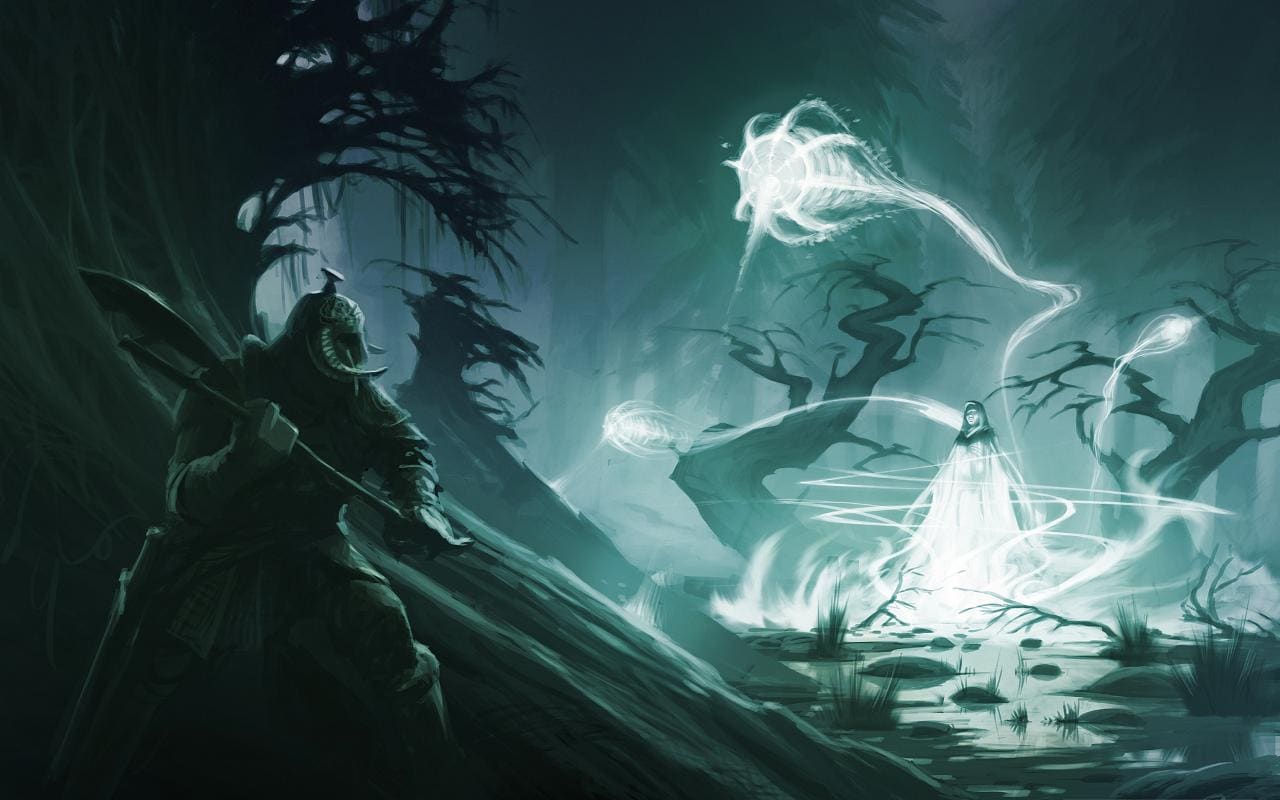
Speaking of feats, they offer some really powerful options to customize your character’s playstyle. There are plenty of feats in 5e to pick from, but some stand out as great options for Necromancers.
Artificer Initiate
Book: Tasha’s Cauldron of Everything
This feat will allow you to dip into the Artificer’s spell list. While there is a lot of overlap with your normal selection of spells, some important exceptions, like Faerie Fire and healing spells. The Artificer also uses Intelligence as their spellcasting modifier, so the spells will slot in nicely with your base build to feel as natural in your kit as your regular spell options.
Metamagic Adept
Book: Tasha’s Cauldron of Everything
Ever since this feat was officially released, I have had difficulty finding a reason not to take it while playing a spellcaster. This feat gives your character a bit of the metamagic feature that is otherwise exclusive to Sorcerers. This gives you even more control over your spells, which is always a nice thing to have when you spend the vast majority of your turns slinging spells.
Shadow Touched
Book: Tasha’s Cauldron of Everything
This feat usually is only slightly useful for Wizards, but I enjoy using it a lot for Necromancers. While most of the bonus spells it gives you access to are already in the Wizard spell list, it also gives you two free spell slots. These can be used to keep two more Undead around with you at all times, which can help a lot since playing this subclass is the main benefit.
Telekinetic
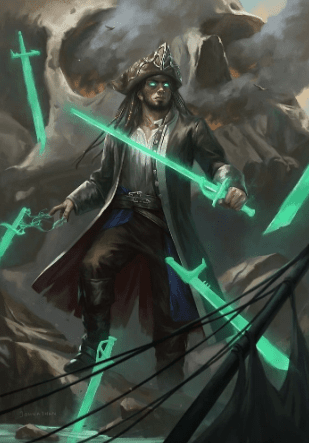
Book: Tasha’s Cauldron of Everything
The Telekinetic feat is a strong utility support option for the Necromancer to pick up. It allows you to spend bonus actions to move targets up to five feet. This may not seem like an important ability. Still, moving enemies or allies around a little bit can help give allies more options during their turn or save vulnerable adventurers from poor positions.
Necromancer Equipment
As a Wizard, your regular equipment won’t matter much since most of your time in combat will be spent casting spells. If you have a decent Dexterity, you can use a Light Crossbow for the first few levels as a dependable damage option, but otherwise, you should opt for a Dagger or even a Rapier.
You also won’t wear any armor or be in plain clothes or robes. Instead, use spells like Mage Armor and Shield to cover yourself if you have to, while at higher levels, you can use Blur or Blink to do the same thing.
The essential part of Necromancer equipment is the magic items that you can gain possession of throughout the campaign. Your build will ultimately depend on which ones your Dungeon Master grants you access to, but these are the items you should keep an eye out for as you play.
Common Magic Items
Hat of Wizardry

Book: Xanathar’s Guide to Everything
This item is a great magic piece of equipment during the early levels of the campaign. The checks required to use it are nominal with your high Arcana, and it will give you access to all of the more situational cantrips available to the Wizard.
This will help you cover more utility and options as the Necromancer, effectively eliminating one of the more limiting aspects of the Wizard’s spellcasting.
Uncommon Magic Items
Arcane Grimoire
Book: Tasha’s Cauldron of Everything
This magical item comes in various iterations and rarities that improve its benefits, but the first it can appear is Uncommon. It grants a boost to your Spell Attack Modifier and Spell Save DC, which are both very useful options.
It also helps you recover more spell slots through Arcane Recovery, enabling you to use your spells more freely, which is always a good thing as a Wizard.
Broom of Flying

Book: Dungeon Master’s Guide
This item is not worth getting if your race granted you a flight, but if it didn’t, this is one of the best flight options at low levels. It doesn’t require attunement and gives you a speed of 50 feet, allowing you to stay at a good range away from fights and reposition quickly when necessary.
Pearl of Power
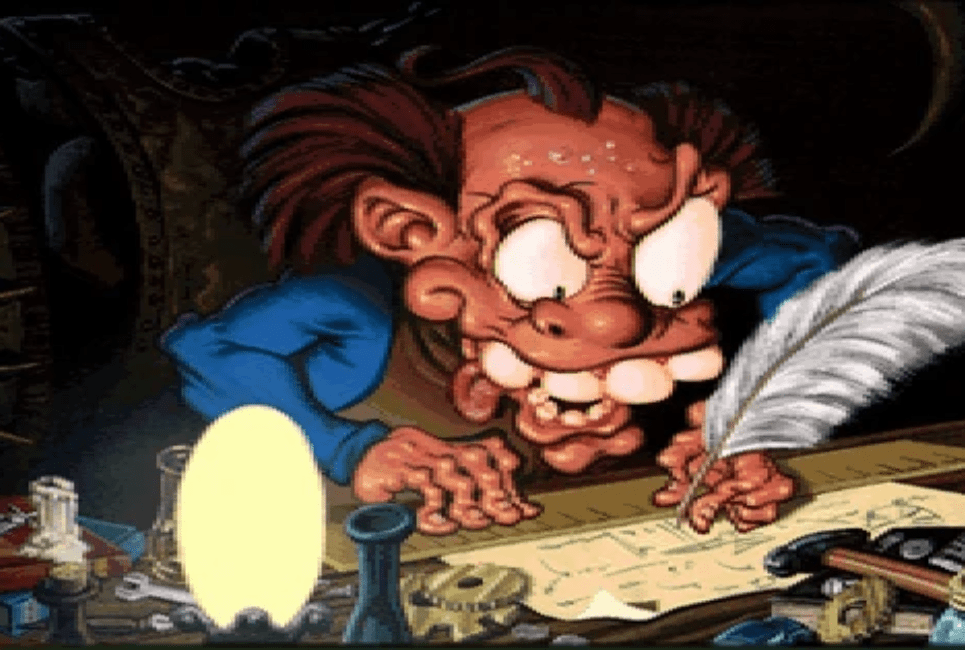
Book: Dungeon Master’s Guide
The Pearl of Power is a good item for any spellcaster, and it can be used to give you a free spell slot each day.
Rare Magic Items
Alchemical Compendium
Book: Tasha’s Cauldron of Everything
The Alchemical Compendium is one of the most complicated magic items in 5e, especially at Rare rarity. This complexity may be overwhelming for newer players, but if you take the time to learn its quirks and explore the possibilities, you can find numerous utilities with this item.
Not only can you use it to circumvent obstacles by turning objects into other objects, but it also can be useful if your game tracks spellcasting components, which play a massive role in raising the dead.
Barrier Tattoo
Book: Tasha’s Cauldron of Everything
This tattoo will boost your Armor Class, saving you from investing in your Dexterity for those few moments you take a hit or two. Since you shouldn’t be in the line of fire too often, you shouldn’t make this one a priority, but it can still be useful to pick it up if the opportunity arises.
Ring of Spell Storing
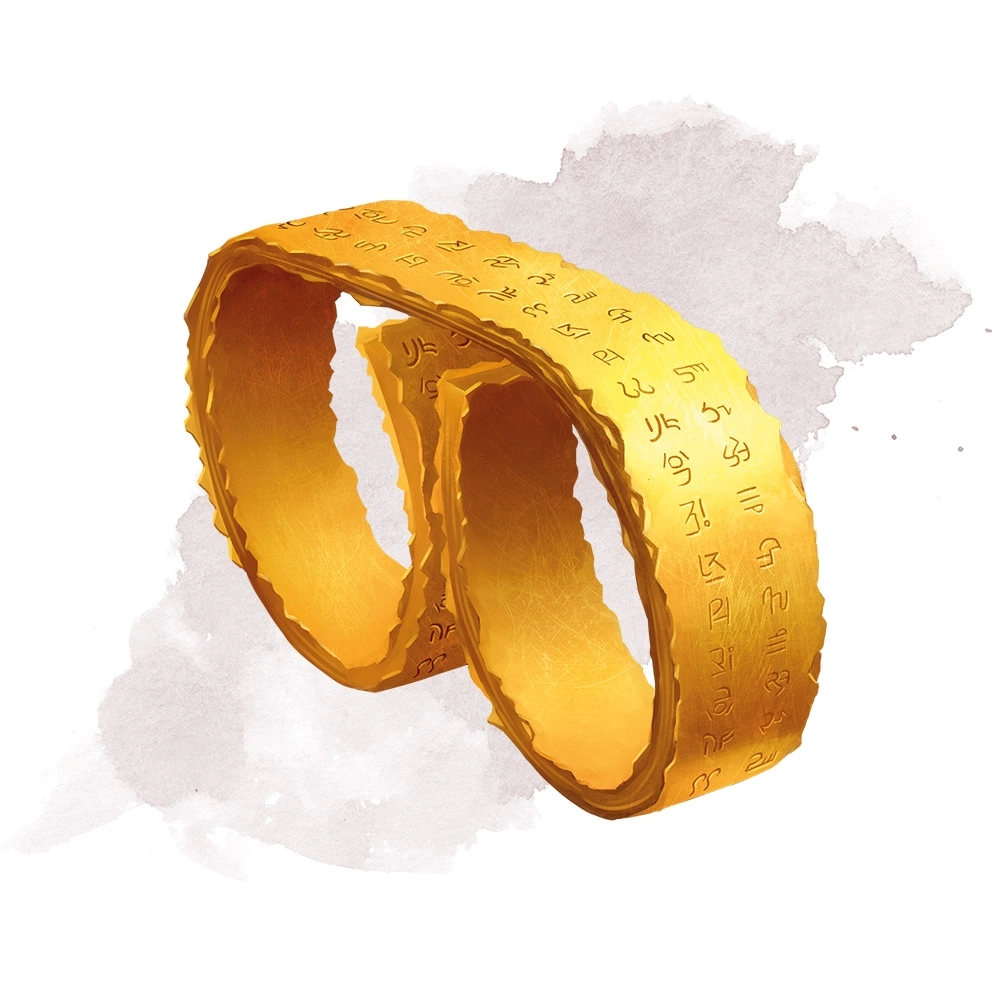
Book: Dungeon Master’s Guide
The benefits of the Ring of Spell Storing are very easy to see. Necromancers cast a lot of spells, and having more spells to cast means they can do more every day.
Very Rare Magic Items
Amulet of the Planes
Book: Dungeon Master’s Guide
This item allows you to travel between the planes, which can be extremely useful for avoiding damage during encounters. Doing so requires an Intelligence check, but by the time you get Very Rare magical items, you should be able to pass it quickly.
Staff of Power
Book: Dungeon Master’s Guide
The Staff of Power brings a ton of benefits to your spellcasting, gives you access to more spells, and acts as a +2 Quarterstaff. While its role as a +2 Quarterstaff won’t be too useful, the increase to your spell damage and attack modifier will help you take advantage of Grim Harvest more frequently in battle, while more spells are always useful.
Tome of Clear Thought
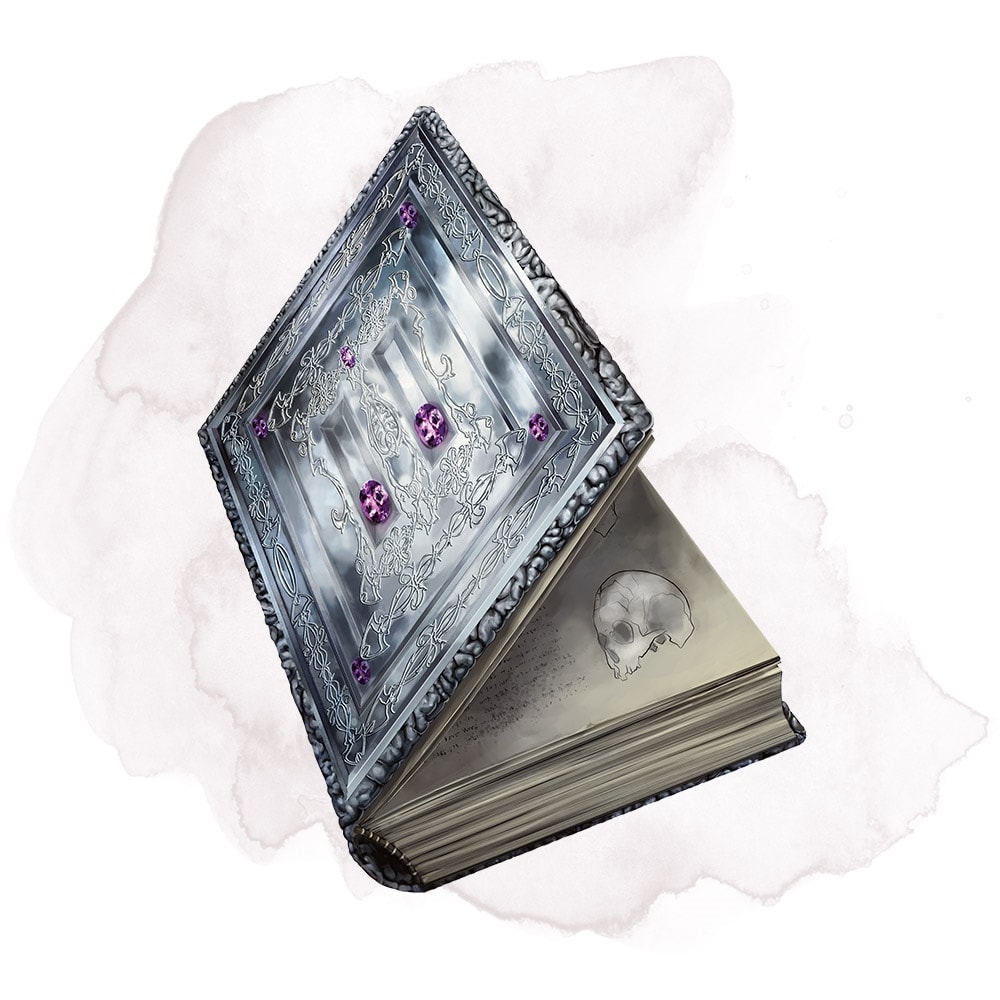
Book: Dungeon Master’s Guide
The tomes that increase ability scores are always useful, and the Tome of Clear Thought is the best for the Necromancer. Reading the tome will permanently increase your character’s level by two and even increase your maximum ability score up to 22, allowing you to get the coveted +6 Intelligence modifier, improving just about everything you do.
Legendary Magic Items
Robe of the Archmagi
Book: Dungeon Master’s Guide
This item effectively combines the effects of a strong spellcasting focus, a rare Barrier Tattoo, and the Mantle of Spell Resistance, making it one of the strongest tools a Wizard can have.
The staff of the Magi
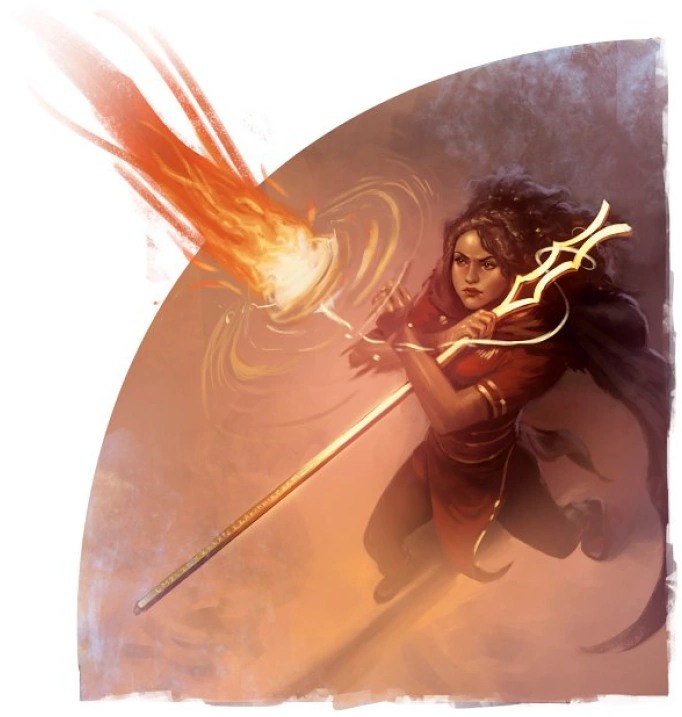
Book: Dungeon Master’s Guide
The Staff of the Magi is an even better version of the Staff of Power. It grants better increases, allows you to absorb spells cast by others to regain its charges, and gives you the ability to cast some of its spells without using spell slots.
Tome of the Stilled Tongue
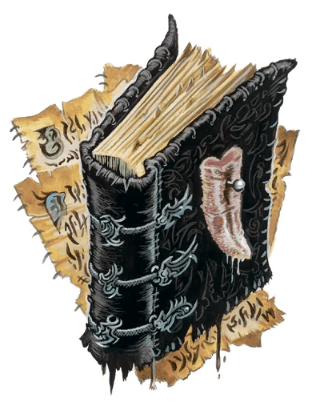
Book: Dungeon Master’s Guide
This spellbook allows you to cast one spell without using a spell slot, regardless of its level. This can be used to keep a powerful Undead under your control for free or to get an extra cast of even a level nine spell, which can be incredibly powerful.
How to Play a Necromancer
Roleplaying
When roleplaying a Necromancer, it is paramount that you pay attention to the negative opinion of Necromancy that most cultures have in DnD. This will likely drive your character to live on the fringes of society, secluded from the judgmental and often angry eyes that surround them in populated areas. How this manifests in their personality is ultimately up to you.
Still, I like to have it show up by the character not being very comfortable in social situations, failing to pick up on social cues, or even having a general distaste for interacting with others. If you take this route, however, you’ll have to make sure not to have it impact your character’s willingness to go with the party, as that will make them unfun to play alongside.
You should also account for your character’s connection to the powers of life and death. This means that your character should view death very differently than most people, whether thinking of it more callously or even being terrified of becoming an undead thrall under the control of another.
Your character’s views on these things should also play into their relationship with the undead they control. They could have a lot of respect for them, treat them like a family pet, or even view them as merely a tool that are accessible to abuse or disregard.
Necromancers are also typically portrayed as creepy or maladjusted in most media. While this stereotype may seem overdone as you flesh out the character in your mind, there is a reason that it is so popular.
That is because it brings a lot of fun potential roleplay opportunities through the contrast of the Necromancer’s sour disposition next to the more normal party members. However, you can also go against the stereotype to mix things up and have a bright and optimistic Necromancer that catches characters off guard when they suddenly start controlling a corpse.
Combat
When it comes to combat, you’ll have to spend a good portion of your time controlling the likes of your Undead. You should have your summons foray into close-ranged combat to deal melee damage and take damage for you and your party members.
This means there can be a lot of bookkeeping since you have to track the stats of each summon individually, but it also frees your turns to use spells and deal extra damage.
While you cast spells, you should try to keep your distance from enemies as much as possible. Then, the spells that you have prepared and cast will depend highly on what you have available to you and what roles are in your party.
If you don’t have a support character, you may want to take more utility spells to cover that role, while you may be able to focus on damage spells to help kill stronger enemies or cull herds with area-of-effect options.
FAQs
Question: What book is the School of Necromancy in?
Answer: The School of Necromancy is in the Player’s Handbook.
Question: What classes should Necromancer’s multiclass with?
Answer: The best class to multiclass with as a Necromancer is the Artificer. The two share the Intelligence spellcasting modifier, and the Artificer can help craft the magic items that can help you get an optimal build.
Question: How many Undead can a Necromancer control in 5e?
Answer: Each Undead that the Necromancer controls consume one spell slot per day, so it is entirely dependent on the Necromancer’s level and how many spell slots they are willing to expend each day on their Undead army.
Conclusion
The Necromancer is a very fun Wizard subclass that brings a unique approach to the game by focusing on managing summons and complimenting them with spells.
The subclass also comes with great roleplay opportunities and is a classic option that any player should be able to have a good time. It also fits well with nearly any campaign style, so you should have no worries when picking this class if it interests you.
- Steel Defender 5e Guide - September 5, 2022
- Harengon 5e Guide - August 24, 2022
- Shambling Mound 5e Guide: The Most Terrifying Plant - August 21, 2022



